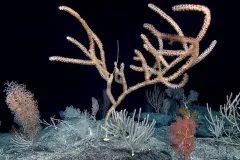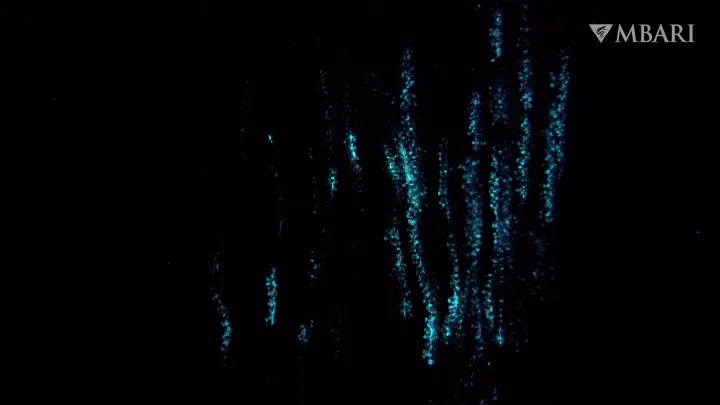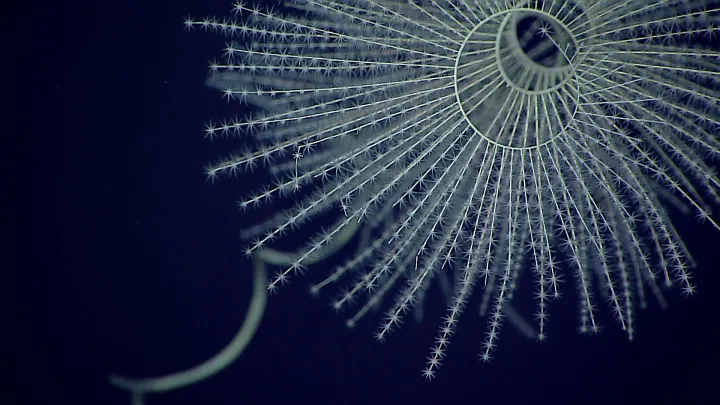New Research in Coral Shines a Light on the Evolution of Bioluminescence

Many animals can glow in the dark via bioluminescence. On land, these animals include fireflies and glow worms. In the ocean, the ability to bioluminesce is widespread within jellyfish, plankton, and corals. And in the deep ocean, scientists estimate that more than 75% of animals can glow.
This natural lightshow has captivated the curiosity of scientists all over the world. Researchers have been diving both deep in the ocean and deep in time to find out when bioluminescence originated, why it came about, and how it spread across so many different species.
One group of scientists with collaborators in the U.S. and Japan recently made a major step in understanding when, how, and why bioluminescence originated. Their paper, published in the journal Proceedings of the Royal Society B, showed that bioluminescence is widespread in many more groups of coral species and that it originated at least 540 million years ago, much earlier than originally thought. This origin, which occurred during the Cambrian period of the Earth’s history, is two times longer ago than scientists previously estimated.
When did bioluminescence originate?
Since time-traveling back to witness the first occurrence of bioluminescence was not an option, the scientists relied on a technique called ancestral state reconstruction to figure out when bioluminescence originated. Ancestral state reconstruction requires scientists to first figure out which current-day corals are able to bioluminesce. To do this, they mechanically stimulated corals in a dark room and observed whether they glowed — kind of like bending a glow stick to see if it will still glow in the dark.
This first step already yielded some interesting insight, as many more corals exhibited bioluminescence than the researchers expected. They found bioluminescence in both major groups, Octocorallia and Hexacorallia, and across a wide range of depths in the ocean.
Then, the researchers used the data about current bioluminescent corals to determine their patterns of bioluminescence in the past. They used a phylogeny, an evolutionary diagram similar to a family tree, to see when the trait might have first appeared. Rather than representing the relationships between human family members, a phylogeny represents the evolutionary relationship between species, with closely related species connected to each other near the tips of the tree.
On a family tree, if someone shares a new trait with all their siblings, that trait likely came from their parents. If they share it with their cousins, too, then the source is further back in time, at their grandparents’ generation. Similarly, if bioluminescence is shared across distantly related coral species, it likely originated a long, long time ago in a distant ancestor.
According to Andrea Quattrini, the study’s principal investigator and curator of corals at the Smithsonian NMNH, “You move backward in time — the more species today that share a trait, the more likely it is that their ancestors are going to share the trait as well.”
Quattrini and her collaborating scientists used the coral phylogenetic tree to trace bioluminescence all the way back to the Cambrian period, where it originated in a single ancestor before being passed down the evolutionary tree as corals diversified.
How did bioluminescence originate?
According to Quattrini and Danielle DeLeo, the leading author on the paper and research fellow at the Smithsonian NMNH, the fact that it originated once and then persisted for so long through time shows that bioluminescence must have had an evolutionary advantage. “The key point is that it arose 540 million years ago, and it’s been retained all this time. It must have been important for fitness for these organisms,” Quattrini said.
Bioluminescence benefited early organisms’ fitness in one of a wide variety of ways, according to DeLeo. Bioluminescence could give organisms an advantage by helping them attract their next meal, acting as an alarm to deter predators, or camouflaging them from predators. In all these cases, bioluminescence is thought to act as one of the earliest forms of communication on Earth.
Another fascinating observation from the study is that coral families with bioluminescence also happen to be the more diverse families — possibly suggesting bioluminescence as a driver of diversification, or as a way to help organisms occupy new habitats. This observation is interesting in the context of the timing; bioluminescence originated during the “Cambrian explosion” when life rapidly became more diverse. The researchers are interested in studying further connections between diversification and bioluminescence to learn whether either of these phenomena is a driver of the other.
Why did bioluminescence originate?
Despite the usefulness of bioluminescence for communication, the researchers think the initial cause for bioluminescence to emerge was completely independent. “There are different theories about why bioluminescence evolved in the first place, and it likely wasn't for communication at first,” Quattrini explained. Instead, the scientists think the chemical reaction that creates bioluminescence evolved to protect cells from excess oxygen in the environment, which was increasing during the Cambrian period. This ability to detoxify the cellular environment of excess oxygen would have been extremely useful and potentially helped these organisms avoid extinction.
Despite this major step forward in understanding bioluminescence, there are still plenty of questions left to answer. Looking ahead, researchers hope to predict whether a coral can bioluminesce using DNA sequencing, which would avoid needing to physically remove and stimulate the coral. They also want to determine why some corals have since lost the ability to bioluminesce.
“We’re hoping that our paper will help get more people thinking about bioluminescence, and look for it,” Quattrini said. “Hopefully people can determine why it was important at that time, a long, long time ago.”




